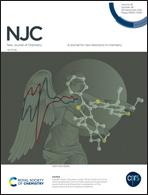Influence of chemical composition on the proton conductivity of microporous organic polymers entrapped in nitrilotrimethylphosphonic acid†
Abstract
The construction of acid–base interactions is critical for developing proton-conducting materials with high loading and stable electrolytes, which is influenced by the chemical composition of conductors. Herein, a microporous furanylimide network (MFN) is screened to immobilize guest molecules (nitrilotrimethylphosphonic acid, NTP) (NTP/MFN) via a simple post-impregnation method. The P–O(OH)2 groups derived from NTP would form acid–base pairs with –NH2/–NH– groups distributed in the MFN backbone. The hybrid membranes with high proton conductivity are developed by embedding NTP/MFN in a chitosan (CS) matrix followed by the solution-blending method. The acid–base pair formed between NTP/MFN and CS optimizes the interfacial interaction and enhances the dispersion of NTP/MFN in the hybrid membrane. The hydrogen-bonding network formed by NTP molecules, MFN, CS and absorbed water molecules constructs the effective proton transfer channels with a low energy barrier for proton transfer, thereby significantly enhancing the proton conductivity of the membrane. In this way, the hybrid membrane (NTP/MFN@CS-2) exhibits a 418-fold enhancement of conductivity over the CS membrane at ∼98% RH and 323 K. Additionally, a thienyl-containing microporous backbone (MTN) as a comparison is employed to evaluate the effect of chemical composition on proton conductivity.



 Please wait while we load your content...
Please wait while we load your content...